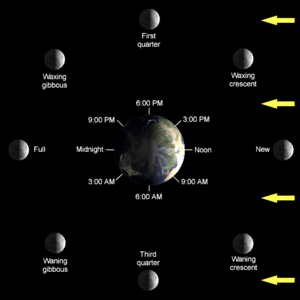New moon
2007 Schools Wikipedia Selection. Related subjects: Space (Astronomy)
The New Moon is the lunar phase that occurs when the Moon, in its monthly orbital motion around Earth, lies between Earth and the Sun, and is therefore in conjunction with the Sun as seen from Earth. At this time, the illuminated half of the Moon faces directly toward the Sun, and the dark or unilluminated portion of the Moon faces directly toward Earth, so that the Moon is invisible as seen from Earth.
New Moon is often considered to occur at the time of the appearance of the first visible crescent of the Moon, after conjunction with the Sun. This takes place over the western horizon in a brief period between sunset and moonset, and therefore the precise time and even the date of the appearance of the New Moon by this definition will be influenced by the geographical location of the observer. The astronomical New Moon, sometimes known as the dark moon to avoid confusion, occurs by definition at the moment of conjunction in ecliptic longitude with the Sun, when the Moon is invisible from the Earth. This moment is unique and does not depend on location, and under certain circumstances it may be coincident with a solar eclipse.
The New Moon is the beginning of the month in lunar calendars such as the Muslim calendar, and in lunisolar calendars such as the Hebrew calendar, Hindu calendars, Buddhist calendar, and Chinese calendar.
Approximate formula
An approximate formula for the average time of New Moon N (conjunction) is
 ,
,
where D is the number of days (and fractions) since 2000-01-01 00:00:00 TT, and N is an integer.
(Note that the number 29.53.. is the synodic month.)
To obtain this moment expressed in Universal Time (world clock time) for future events (N>0), apply the following approximate correction:
 days
days
Periodic perturbations change the time of true conjunction from these mean values. For all New Moons between 1601 and 2401, the maximum difference is 0.592 days = 14h13m in either direction.
The duration of a lunation (from New Moon to the next New Moon) varies in this period between 29.272 and 29.833 days, i.e. -0.259d = 6h12m shorter, or +0.302d = 7h15m longer than average. This range is smaller than the difference between mean and true conjunction, because during the lunation the periodic terms cannot all change to their maximum opposite value.
See the paper on the full moon cycle for a fairly simple method to compute the moment of New Moon more accurately.
The long-term error of the formula is approximately: 1*cy*cy seconds in TT, and 11*cy*cy seconds in UT (cy is centuries since 2000 — see section Explanation of the formulae for details.)
Explanation of the formulae
The moment of mean conjunction can easily be computed from an expression for the average ecliptic longitude of the Moon minus the average ecliptic longitude of the Sun (Delauney parameter D). The expression given is based on the paper by Chapront et al. , with the following corrections:
constant term:
- Applied the constant terms of the aberration to obtain the apparent difference in ecliptic longitudes:
- Sun: +20.496"
- Moon: −0.704"
- Correction in conjunction: −0.000451 days.
- For UT: at 1 Jan. 2000, ΔT was +63.83 s; hence the correction for the clock time of the conjunction is:
- −0.000739 days.
quadratic term:
- In ELP2000–85 (see ), D has a quadratic term of −5.8681"*T2; expressed in lunations N, this yields a correction of +87.403E–12*N2 days to the time of conjunction. The term includes a tidal contribution of 0.5*(−23.8946 "/cy2). The most current estimate from Lunar Laser Ranging is (see ): (−25.858 ±0.003) "/cy2. Therefore the tidal correction to the quadratic term in D is −0.9817*T2". The polynomial provided by Chapront et al. (ref. ) provides the same value. This translates to a correction of +14.622E−12*N2 days; the quadratic term now is:
- +102.026E−12*N2 days.
- For UT: analysis of historical observations show that ΔT has a long-term increase of +31 s/cy2. Converted to days and lunations, the correction from ET to UT becomes:
- −235E−12*N2 days.
The theoretical tidal contribution to ΔT is about +42 s/cy2; the smaller observed value is due to changes in the shape of the Earth. The uncertainty of our prediction of UT (rotation angle of the Earth) may be as large as the difference between these values: 11 s/cy2. The error in the position of the Moon itself is only maybe 0.5 "/cy2, or 1 s/cy2 in the time of conjunction with the Sun.
Religious use
The Islamic calendar has retained an observational definition of the New Moon, marking the new month when the first Crescent Moon is actually seen, and making it impossible to be certain in advance of when a specific month will begin (in particular, the exact date on which Ramadan will begin is not known in advance). In Saudi Arabia, if the weather is cloudy when the New Moon is expected, observers are sent up in airplanes. In Iran a special committee receives observations of every new moon to determine the beginning of each month. This committee uses one hundred groups of observers.
The New Moon is the beginning of the month in the Chinese calendar. Some Buddhist Chinese keep a vegetarian diet on the New Moon and Full Moon each month.
Trivia
- In the anime and manga InuYasha, this is the time where the hanyō Inuyasha loses his yōkai powers temperarily and turns full human for the night.
Literature
- M.Chapront-Touzé, J.Chapront: "ELP2000-85: a semianalytical lunar ephemeris adequate for historical times". Astron.Astrophys. 190, 342..352 (1988)
- J.Chapront, M.Chapront-Touzé, G.Francou: " A new determination of lunar orbital parameters, precession content, and tidal acceleration from LLR measurements". Astronomy & Astrophysics 387 (2002) 700–709
